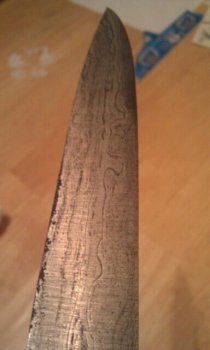There seems to be alot of talk lately about "slag inclusions" or metal having a "grain" direction. In a comercial steel, this is probably unlikely. It is something else that someone is seeing, while I can't comment on what exactly it is, I can almost certainly guarantee that it isn't slag.
I work with alot of bloomery material that I make myself, THIS material may benifit from forging to shape over stock removal, as it definatly contains slag "stringers". I'm sure that this is where the myth that forging creates a better blade comes from, as the material certainly needs forge folding and working to get it to behave like a bar of steel. After about a year of working bloomery material, I find it very funny when people complain about stringers in their comercial steel, almost to the point that I feel that it's an insult to those of us who choose to work with the "old" material.
Simple fact, if you're working comercial steel that you feel has a problem, contact the supplier or steel mill, I'm sure that the "problem" will be fixed. If you really want to see what working a slagged up metal is like, build yourself a stack and get to work chopping charcoal and crushing and roasting ore, tis alot of work, but the steel is beautiful, and probably not as strong of a blade as you could make from some 1075.
Here's a pic of a blade forged from some bloom steel, you can see the little specks in it that are the slag, and it takes alot of work to get it this far.

I've yet to see any pics from comercial steel that look like that
This post isn't a stab at anyone, just my opinion that what some people are seeing in their steel isn't slag, or an inclusion. I see the real thing every time I work bloomery material, some has more, some has less.
Zeb
I work with alot of bloomery material that I make myself, THIS material may benifit from forging to shape over stock removal, as it definatly contains slag "stringers". I'm sure that this is where the myth that forging creates a better blade comes from, as the material certainly needs forge folding and working to get it to behave like a bar of steel. After about a year of working bloomery material, I find it very funny when people complain about stringers in their comercial steel, almost to the point that I feel that it's an insult to those of us who choose to work with the "old" material.
Simple fact, if you're working comercial steel that you feel has a problem, contact the supplier or steel mill, I'm sure that the "problem" will be fixed. If you really want to see what working a slagged up metal is like, build yourself a stack and get to work chopping charcoal and crushing and roasting ore, tis alot of work, but the steel is beautiful, and probably not as strong of a blade as you could make from some 1075.
Here's a pic of a blade forged from some bloom steel, you can see the little specks in it that are the slag, and it takes alot of work to get it this far.

I've yet to see any pics from comercial steel that look like that
This post isn't a stab at anyone, just my opinion that what some people are seeing in their steel isn't slag, or an inclusion. I see the real thing every time I work bloomery material, some has more, some has less.
Zeb
